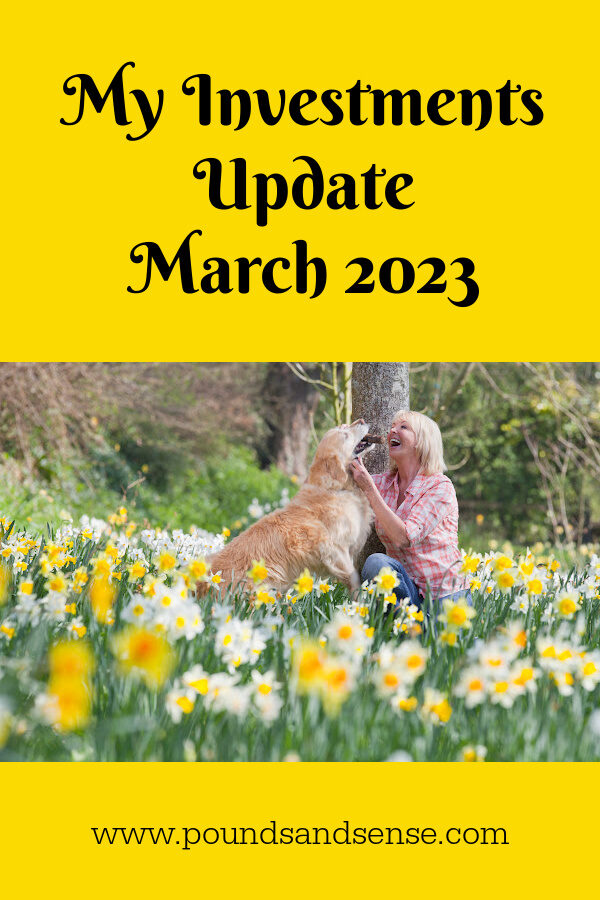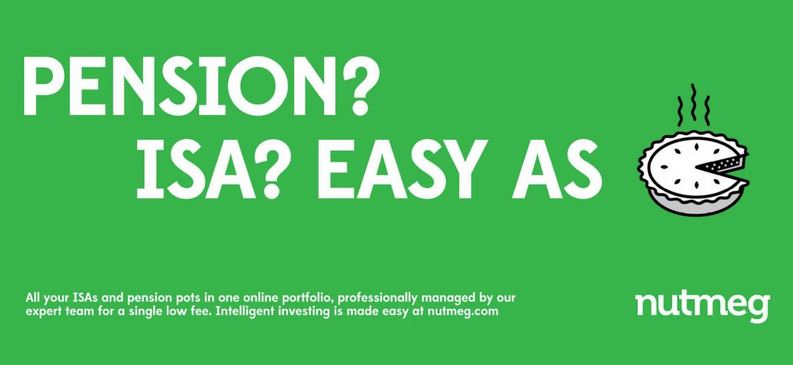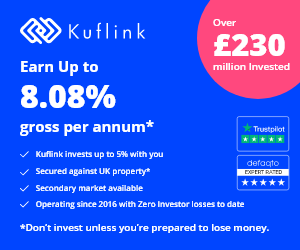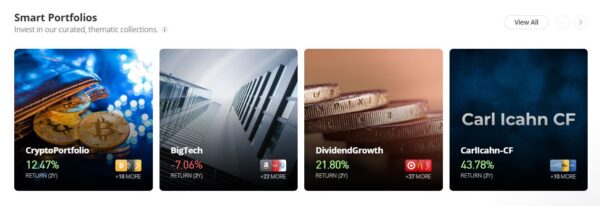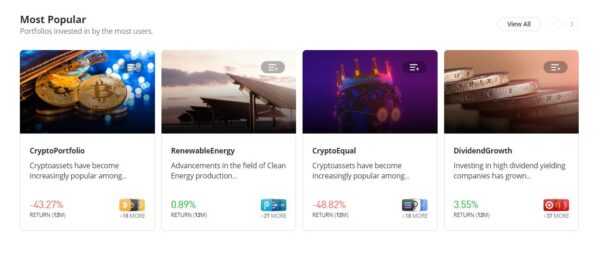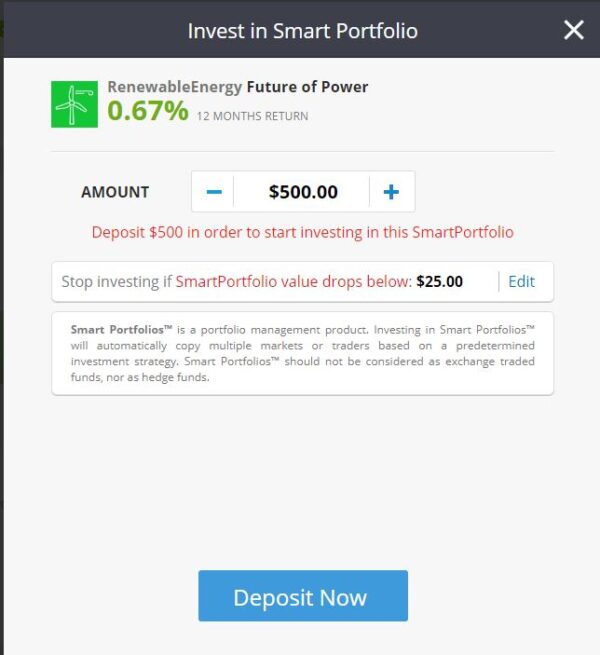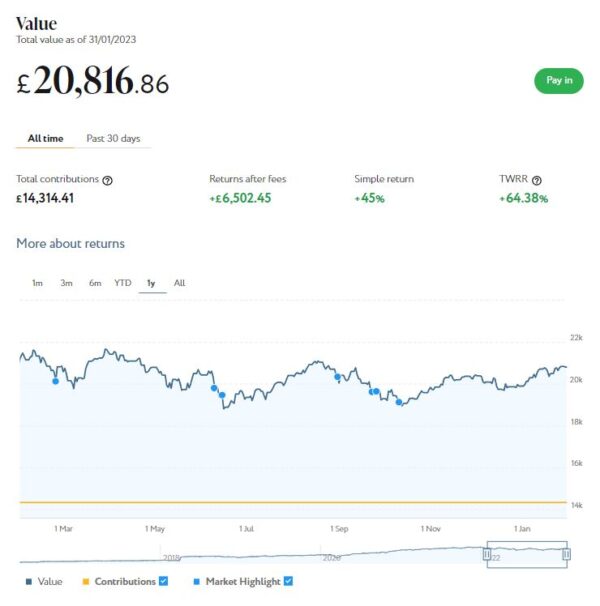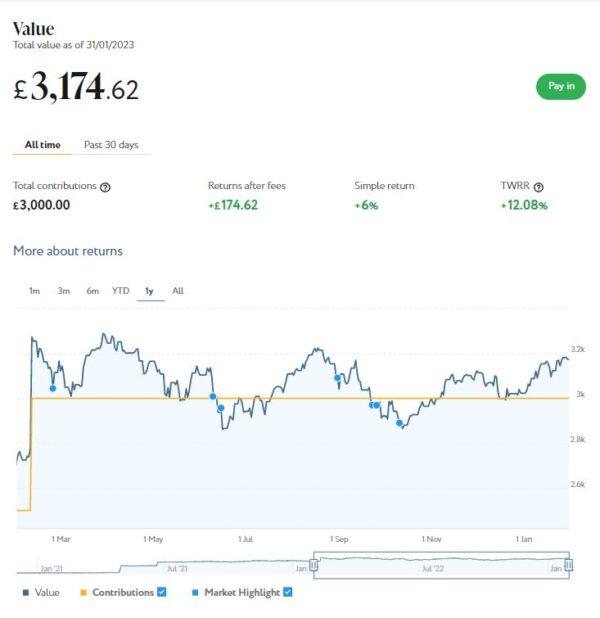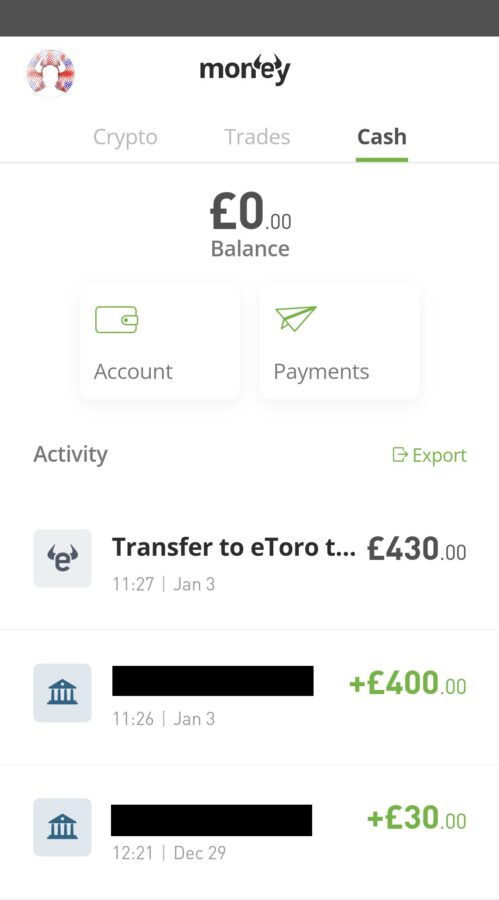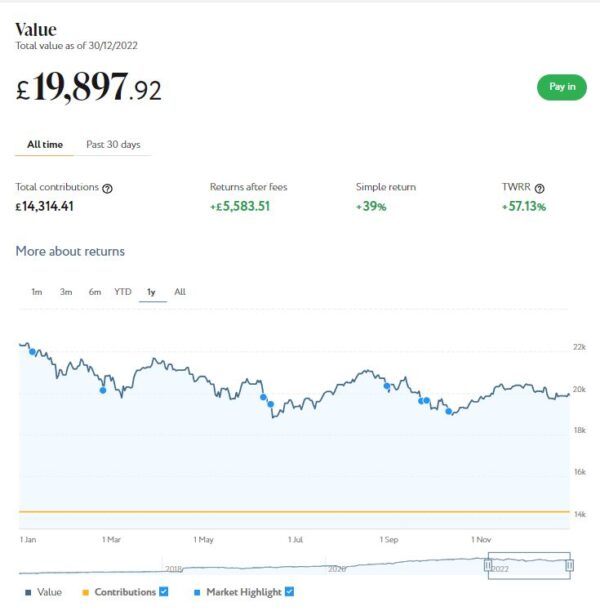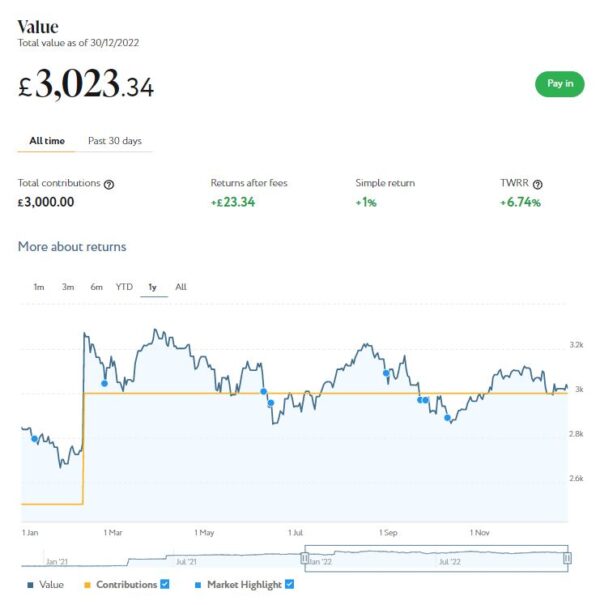My Investments Update – March 2023
Here is my latest monthly update about my investments. You can read my February 2023 Investments Update here if you like
I’ll begin as usual with my Nutmeg Stocks and Shares ISA. This is the largest investment I hold other than my Bestinvest SIPP (personal pension), from which I recently started withdrawing again.
As the screenshot below of performance for the year to date shows, my main Nutmeg portfolio is currently valued at £20,680. Last month it stood at £20,817 so that is a fall of £137.
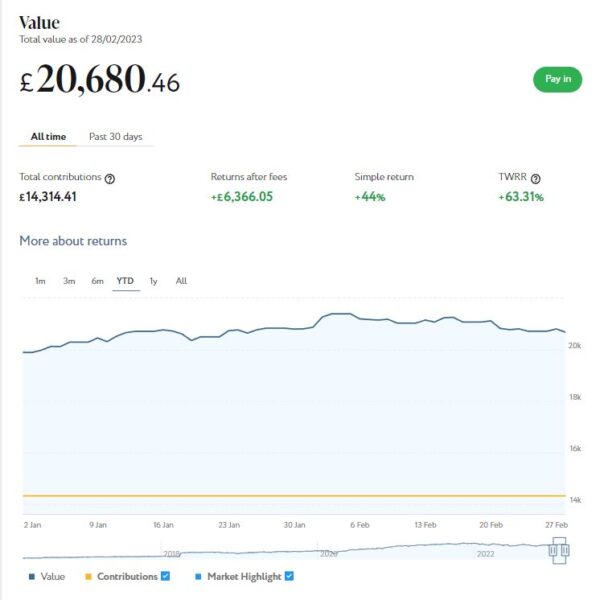
Apart from my main portfolio, I also have a second, smaller pot using Nutmeg’s Smart Alpha option. This is now worth £3,162 compared with £3,174 a month ago, a small drop of £12.
Here is a screen capture showing performance since the start of this year.
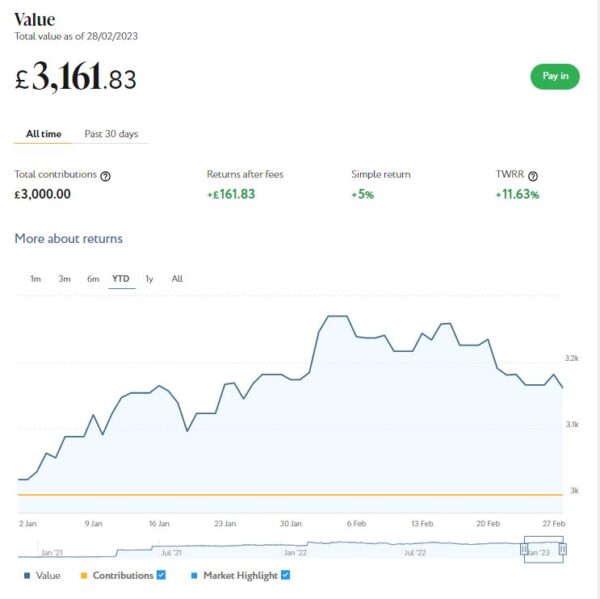
The general profile for both portfolios is similar, with rises in the first half of February followed by falls in the last fortnight or so. The total value of both portfolios has fallen by £149 or 0.62% month on month. That is obviously a little disappointing, but both are still comfortably up on where they were at the start of the year. And their total value has risen by almost £2,000 (8.61%) since mid-October last year.
Of course, all investing is (or should be) a long-term endeavour. Over a period of years stock market investments such as those used by Nutmeg typically produce better returns than cash accounts, often by substantial margins. But there are never any guarantees, and in in the short to medium term at least, losses are always possible.
You can read my full Nutmeg review here (including a special offer at the end for PAS readers). If you are looking for a home for your annual ISA allowance, based on my overall experience over the last seven years, they are certainly worth considering. They offer self-invested personal pensions (SIPPs) as well.
Moving on, my Assetz Exchange investments continue to generate steady returns. Regular readers will know that this is a P2P property investment platform focusing on lower-risk properties (e.g. sheltered housing). I put an initial £100 into this in mid-February 2021 and another £400 in April. In June 2021 I added another £500, bringing my total investment up to £1,000.
Since I opened my account, my AE portfolio has generated a respectable £103.38 in revenue from rental income. As I said in last month’s update, capital growth has slowed, though, in line with UK property values generally.
Even so, it’s not all bad news. At the time of writing 15 of ‘my’ properties are showing gains, 2 are breaking even, and 8 are showing losses (two fairly substantial). My portfolio is currently showing a very small net increase in value of £0.31, meaning that overall (rental income plus capital gains) I am up by £103.69. That is still a decent rate of return on my £1,000 and does illustrate the value of P2P property investments for diversifying your portfolio. And it doesn’t hurt that with Assetz Exchange most projects are socially beneficial as well.
- To control risk with all my property crowdfunding investments nowadays, I invest relatively modest amounts in individual projects. This is a particular attraction of AE as far as i am concerned. You can actually invest from as little as 80p per property if you really want to proceed cautiously.
My investment on Assetz Exchange is in the form of an IFISA so there won’t be any tax to pay on profits, dividends or capital gains. I’ve been impressed by my experiences with Assetz Exchange and the returns generated so far, and intend to continue investing with them. You can read my full review of Assetz Exchange here. You can also sign up for an account on Assetz Exchange directly via this link [affiliate].
Another property platform I have investments with is Kuflink. They continue to do well, with new projects launching almost every day. I currently have around £2,500 invested with them in 18 different projects. To date I have never lost any money with Kuflink, though some loan terms have been extended once or twice. On the plus side, when this happens additional interest is paid for the period in question.
My loans with Kuflink pay annual interest rates of 6 to 7.5 percent. These days I invest no more than £200 per loan (and often less). That is not because of any issues with Kuflink but more to do with losses of larger amounts on other P2P property platforms in the past. My days of putting four-figure sums into any single property investment are behind me now! Nowadays I mainly opt to reinvest the monthly repayments I receive from Kuflink, which has the effect of boosting the percentage rate of return on the projects in question
Obviously a possible drawback with Kuflink and similar platforms is that your money is tied up in bricks and mortar, so not as easily accessible as cash savings or even (to some extent) shares. They do, however, have a secondary market on which you can offer any loan part for sale (as long as the loan in question is performing and not in arrears). Clearly that does depend on someone else wanting to buy it, but my experience has been that any loan parts offered are typically snapped up very quickly. So if an urgent need arises, withdrawing your money (or part of it) is unlikely to be an issue.
You can read my full Kuflink review here. They offer a variety of investment options, including a tax-free IFISA paying up to 7% interest per year with built-in automatic diversification. Alternatively you can now build your own IFISA, with most loans on the platform (including the one shown above) being IFISA-eligible.
- You may like to know that until 31 May 2023 Kuflink are offering enhanced promotional rates of up to 9.73% (gross annual interest equivalent rate) for their Auto-Invest products (IFISA-eligible). There is limited availability for this offer and it may be withdrawn any time before 31 May 2023 if the limit is reached. For more information, click here [affiliate link].
Last year I set up an account with investment and trading platform eToro, using their popular ‘copy trader’ facility. I chose to invest $500 (then about £412) copying an experienced eToro trader called Aukie2008 (real name Mike Moest).
In January I added to this with another $500 investment in one of their thematic portfolios. I also invested a small amount I had left over in Tesla shares. My original investment of $1,022.26 is today worth $1,102.18, an increase of $79.92 or 9.43%. in these turbulent times I am very happy with that.

As you can see, my big success has been investing in Tesla at the right time, as their share price has risen by over 85%. If only I had put more than $19 into this!
My copy trading portfolio with Aukie2008 is still well in profit, though it has fallen a bit in the last week or two. My most recent investment in Oil Worldwide, having started well, is now down fractionally. But I’m certainly not going to worry about that at the moment.
You can read my full review of eToro here. You may also like to check out my more in-depth look at eToro copy trading. I also discussed thematic investing with eToro using Smart Portfolios in this recent post. The latter also reveals why I took the somewhat contrarian step of choosing the oil industry for my first thematic investment.
- eToro also recently introduced the eToro Money app. This allows you to deposit money to your eToro account without paying any currency conversion fees, saving you up to £5 for every £1,000 you deposit. You can also use the app to withdraw funds from your eToro account instantly to your bank account. I tried this myself recently and was impressed with how quickly and seamlessly it worked. You can read my blog post about eToro Money here.
I had two more articles published in February on the always-excellent Mouthy Money website. One is Make Extra Money Renting a Room. This is an ‘old school’ method for making some extra cash, but none the worse for that. If you have a spare room (or rooms) in your home that you don’t mind letting out, you can generate a steady income by doing this. And under the government’s Rent a Room Scheme, you can make up to £7,500 a year tax-free.
My other piece was How to Become a TV or Movie Extra. This opportunity won’t make you rich but can certainly generate a useful sideline income and provide a lot of fun into the bargain (as I can testify from personal experience!).
My other Pounds and Sense blog posts from February include How to Make More Money From National Grid Powersaving Events. This opportunity is only open to you if you have a smart meter – but if so, you definitely need to see this 🙂
I also recommend reading (if you haven’t already) Are You Making the Most of Your Annual ISA Allowance? With the 2022/23 tax year ending in just a few weeks, it really is a case of ‘Use it or lose it’ now for your £20,000 tax-free ISA allowance. With other tax-free allowances already set to be slashed in the years ahead, it’s more important than ever to make the most of this one while you can.
Also in February I revealed how you can Get Your Will Written Free of Charge in March. And finally, do see as well Keep in Touch With Pounds and Sense, as this explains how to ensure you never miss another PAS blog post in future!
That’s all for today. I hope you and your family are coping in these challenging times. Don’t forget to check out the government’s Help for Households website, which sets out various types of financial assistance you may be entitled to and is regularly updated.
As always, if you have any comments or queries, feel free to leave them below. I am always delighted to hear from PAS readers
Disclaimer: I am not a qualified financial adviser and nothing in this blog post should be construed as personal financial advice. Everyone should do their own ‘due diligence’ before investing and seek professional advice if in any doubt how best to proceed. All investing carries a risk of loss.
Note also that posts may include affiliate links. If you click through and perform a qualifying transaction, I may receive a commission for introducing you. This will not affect the product or service you receive or the terms you are offered, but it does help support me in publishing PAS and paying my bills. Thank you!

